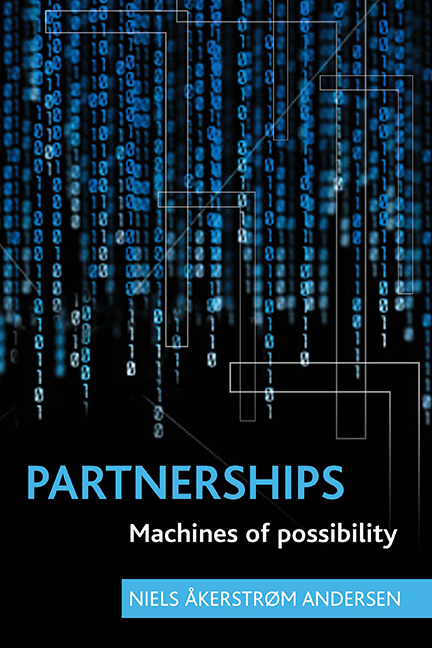Book contents
- Frontmatter
- Contents
- List of tables and figures
- Preface and acknowledgements
- Introduction
- one Analytical strategy
- two Articulating partnerships
- three Outsourcing limits
- four Contracts and relationality
- five Contracts as communication
- six Partnerships as second‑order contracts
- seven Partnerships as tentative structural coupling
- eight Partnerships as second‑order organisations
- Conclusion
- References
- Index
eight - Partnerships as second‑order organisations
Published online by Cambridge University Press: 13 January 2022
- Frontmatter
- Contents
- List of tables and figures
- Preface and acknowledgements
- Introduction
- one Analytical strategy
- two Articulating partnerships
- three Outsourcing limits
- four Contracts and relationality
- five Contracts as communication
- six Partnerships as second‑order contracts
- seven Partnerships as tentative structural coupling
- eight Partnerships as second‑order organisations
- Conclusion
- References
- Index
Summary
Up to this point partnerships have been studied in two different ways: as second-order contracts and as structural coupling. Subsequently we have explored what this means for the character of the partnership as structural coupling between different function systems, and concluded that there are significant differences in the potential of first- and second-order contracts to establish structural couplings. In this chapter we explore the relation between contract and organisation in relation to partnerships, putting important constitutive conditions at stake. As it is, second-order contracts seem to be able to simultaneously function as a contract and as an organisation. Partnerships seem to represent the impossible figure of self-organising contracts.
The literature on both contracts and organisations often maintains a distinction between them. An organisation represents a system for decision making. A contract represents a relation of exchange.
In a systems-theoretical sense, an organisation can be seen as a system of communication that communicates through the operation of decision, creates itself through its decisions and consists solely of a network of decided premises for decision. Organisations are nothing more than an accompanying by-product of the unfolding of decision as form. Organisations and their elements are established through decision communication when decisions confirm decisions and turn them into premises for decision. ‘What’ an organisation is and consists of becomes a result of the way in which organisations deparadoxify decisions and translate them into premises for decision. The point is that organisation systems create themselves through decisions and what a decision is is also established through decisions. Therefore, a decision as the system's formative operation also creates itself. This is the autopoiesis of organisations. No element in an organisation is the product of anything but the unfolding of the decision paradox. A decision decided itself by deciding on premises for decision, and the decision of these premises causes the organisational system to emerge as the unity of decision connections. It remains an open question how a premise becomes a premise. This varies from one organisation to the next, but the historical conditions of possibility for the construction by organisations of premises are also changed through changes in the language, the semantics, which the decision communication has at its disposal.
- Type
- Chapter
- Information
- PartnershipsMachines of Possibility, pp. 127 - 136Publisher: Bristol University PressPrint publication year: 2008



